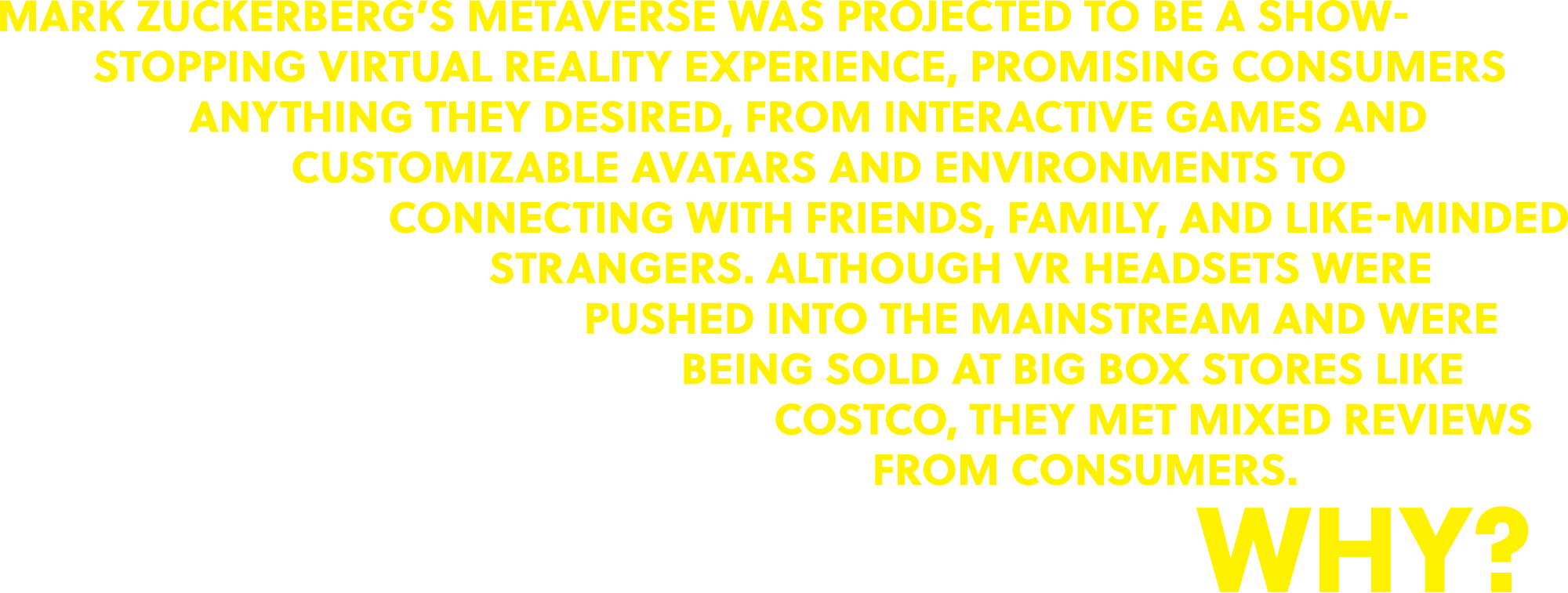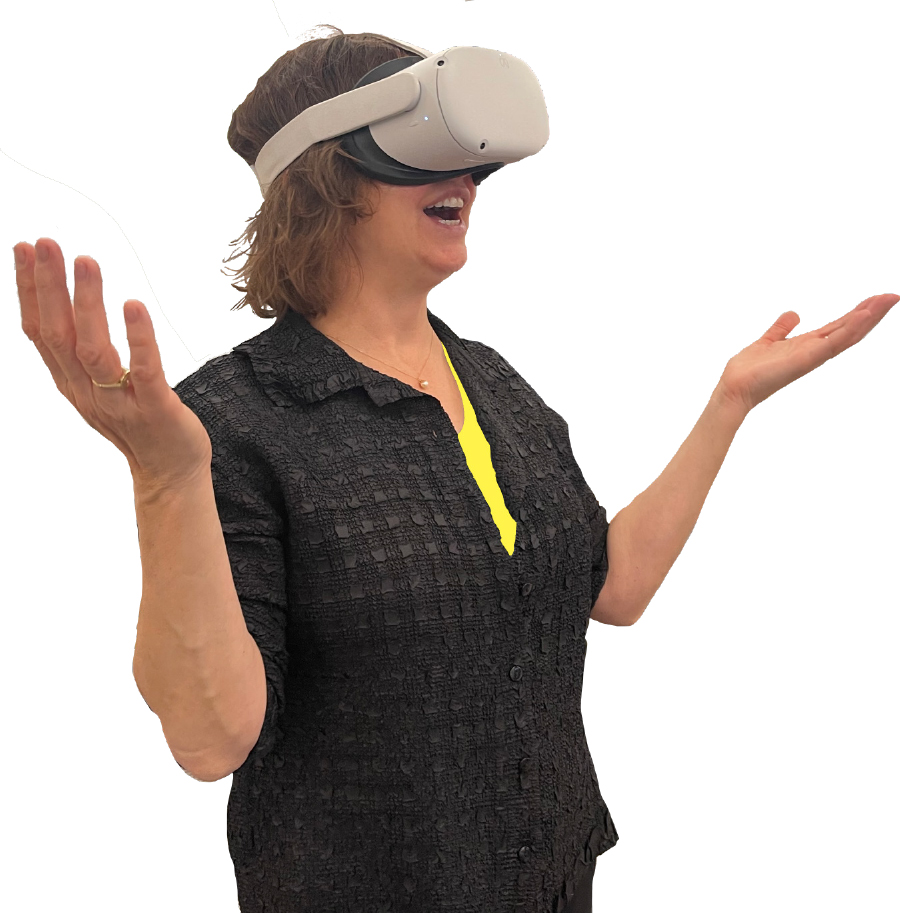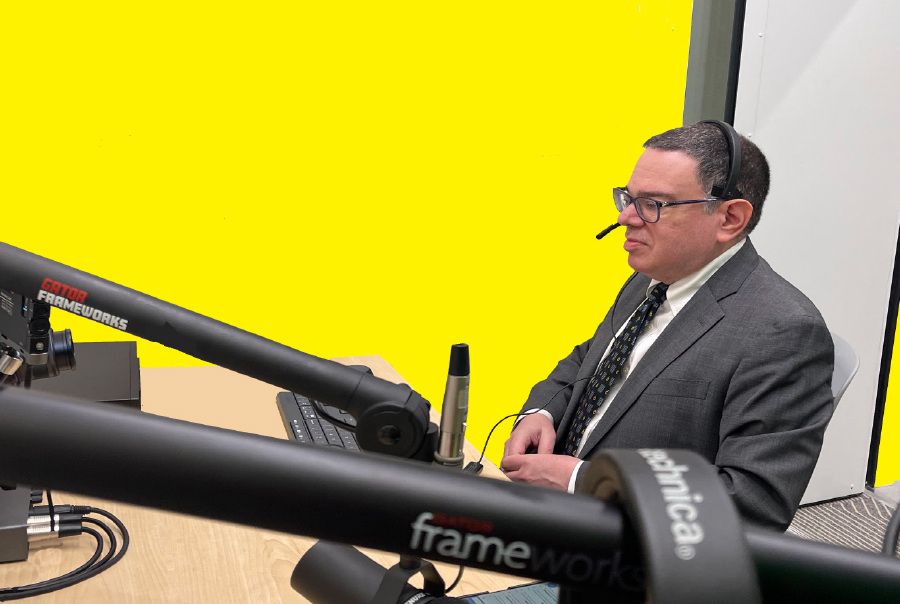Bringing Learning to Life at LITE, Fordham’s Learning and Innovation Technology Environment

Why?
Bringing Learning to Life at LITE, Fordham’s Learning and Innovation Technology Environment
Why?
abelli School of Business M.B.A. students investigate that question in the course Consumer Adoption of New Media taught by Assistant Clinical Professor Janet Gallent, Ed.D. With the support of Fordham University’s Learning and Innovation Technology Environment (LITE) center based on the Rose Hill Campus, Gallent was able to offer her students an engaging, hands-on learning opportunity so they could answer the question for themselves.
“Students are instructed to act like a consumer and think like a consultant,” she said, as they immerse themselves in VR experiences using Meta Oculus Quest 2 headsets made available to them through LITE. “Their virtual reality experiences start with Meta’s First Steps, an introduction to VR technology,” she explained. “Then, they are ready to engage in Meta’s Rec Room, which is a VR social space that enables them to play games and chat with users from all around the world.”
According to a poll conducted by Gallent last semester, only 30% of the participants had previous experience with VR headsets, while all of the others were trying the technology for the first time. In the end, 82% of the students reported that the VR experience “informed their perspective on why VR hasn’t taken off yet.” The barriers they identified included the comfort of the headset itself, the hand-eye coordination necessary for navigation, and the life of the battery, which could impact the overall experience.
As Gallent points out, VR is already being used across many industries, including healthcare, tourism, law enforcement, and skilled trades. Business professionals are using VR in a wide range of ways, including: brand advertising and virtual storytelling; virtual tours, from museums and travel to real estate viewings and fashion shows; product testing; employee training and collaboration; and many others.
Gallent brings two decades of experience to her role at the Gabelli School. Before joining the Communications and Media Management faculty in 2021, she was the senior vice president of consumer insights and innovation research at NBCUniversal and head of the company’s research lab at Universal Orlando Theme Park. She led research projects for NBCUniversal’s entertainment, news, and sports divisions. Findings from her studies informed both tactical and strategic decisions across the business, including marketing, programming, sales, and business development.

“When you have something like the LITE center where everybody can get their hands on the same experience and have a conversation, it’s great,” she said. “I am very grateful for what the center has enabled me to do. I show my students the podcasting room because, ideally, I want to use as many forms of media to allow them to communicate and have those experiences.”
Putting the Spotlight on Emerging Technology
The facility features the latest in cutting-edge technology. The Maker Space is equipped with 3D printers, 3D scanners, photogrammetry, laser engraving, 360 cameras, and more. The virtual reality suite has several VR headsets and an augmented reality HoloLens headset. Faculty and students can record podcasts in fully outfitted, private podcasting rooms. Collaborative work areas and an assistive technology workstation ensure that the facility is accessible to all. What’s more, LITE hosts a series of educational information sessions called “SpotLITE” on such topics as ChatGPT, the ethics of AI, podcasting, Google Jamboard, and 3D production.
Fleur Eshghi, Ed.D., associate vice president of educational technology research computing, said that LITE was conceptualized and designed to bring a comprehensive, integrated “learning commons” to the Fordham community.
“Its resources can be used by researchers and students alike to ask questions that they may not previously have been equipped to answer, and the ideas spawned may take on new life as unexplored dimensions emerge, forging new paths of study,” she said. “It can also just be a destination for students in and of itself, providing fun options for those looking to exert their creativity.”
Members of the Fordham community can rent laptops and other equipment for projects, and tap the expertise of LITE’s staff members in the integrated technology support center and at the information desk. A true hub of creativity and innovation, LITE also stocks some classic tools, such as a Singer sewing machine, scissors, and glue.
Nicole Zeidan, Ed.D., assistant director of emerging educational technology and learning space design, helps to oversee LITE’s day-to-day operations. Noting that several business faculty and students have been taking advantage of the facility since its opening, Zeidan acknowledged the momentum of these emerging technologies in the business world and virtually across all industries, making it essential for today’s students to have access to them and experience using them by the time they are preparing to enter the workforce.

An Illuminating Senior Thesis
“Instead of the typical Excel or Tableau, you need a VR headset to view [the data], and it can be very interactive,” Wernoch said. “I wanted to see how students felt about the program, if it was relatively easy to use, and if they thought it was a good application.”
Wernoch was awarded a grant to purchase the VR program made by D6, a subsidiary company of The Glimpse Group, which specializes in VR technology. The program was designed as a new way for business professionals to present their data and impress potential clients. The student tested it out on VR headsets provided by LITE before bringing in groups of students to record their observations.
Overall, 30 participants agreed that the 3D visualization would help them better organize their data and, with multiple headsets, allow for easy collaboration. Now a tax technology consultant for Deloitte, Wernoch works with a different set of technologies, but his research and early exposure to VR at LITE was an important first step in testing new technologies and seeing firsthand how they could shape the future.
“The whole process was a great learning experience,“ he said. “Without the staff and the space itself, this research wouldn’t have been possible.”
A Professional Space to Interview Sports Figures
“The last few years, all of the [interviews] were on Zoom, which has made things a lot easier because we’re able to interview people from wherever they are and not have to bring them to Fordham’s campus,” he said. “A great deal of my work has been in the LITE center, which has state-of-the-art cameras and sound.”
Conrad added that he also wanted to start podcasting. It’s better for me and it’s easier to produce,” he said. “We want to make a page for podcasts, which will all be done in the studio. I’ll do the commentaries and interviews either live or via Zoom.”
Technology Inspires Creativity & Collaboration
During the final exam, groups of students were posed with challenges and collaborated at each of the five stations to come up with creative solutions. At one station, students used Google’s Jamboard, a digital whiteboard that lets individuals collaborate in real-time, to redesign the first floor of the Walsh Library in a way that brings more of the campus’ stunning external environment into the building. At another, students redesigned a Starbucks store to include more collaborative workspaces. In the recording studios, students developed edutainment podcasts based on Thomas Edison’s “Five Competencies of Innovation.” In the VR space, a group created onboarding programs using VR to redesign the experience. Students at the final station used Tinkercad, a web app for 3D design, to create a new product with an option to produce it on LITE’s 3D printer.
The final session of the exam took place in a collaborative workspace at LITE. Each group presented their project and shared their experiences working with LITE’s resources to apply their knowledge and bring their ideas to life.
“Using these resources and engaging with new technology supports the purpose of this class and helps students to achieve learning objectives,” Haber said. “In addition to amplifying the theme of what I am teaching, it also allows students to develop skills and experience with technology that they can use in other classes and beyond.”